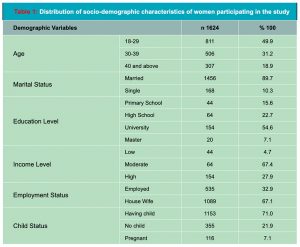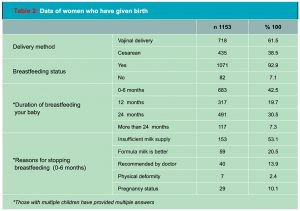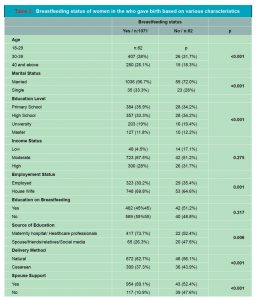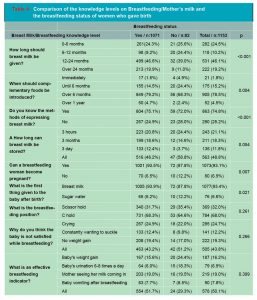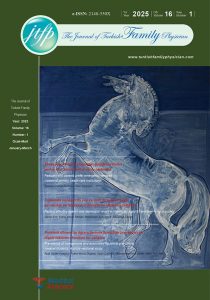İnegöl’de yaşayan kadınların anne sütü farkındalığını ve emzirmeyi etkileyen faktörler
Amaç: Çalışmamızda, İnegöl’de yaşayan kadınların anne sütü ve emzirme ile ilgili düşüncelerinin öğrenilmesi, bu konudaki tutum ve davranışlarını etkileyen faktörlerin belirlenmesi amaçlanmıştır.
Yöntem: 10 Nisan-10 Haziran 2023 tarihleri arasında İnegöl’de yaşayan 18-60 yaş arası 1624 kadınla yapılmış kesitsel tipte bir çalışmadır. Veriler; tanıtıcı bilgi formu, emzirme/anne sütü tutum formu ile Google anket kullanılarak toplanmıştır. Veriler, sayı ve yüzde olarak sunulmuştur. Kategorik değişkenleri karşılaştırmak için ki-kare testi kullanılmış ve p<0,05 düzeyi istatistiksel olarak anlamlı kabul edilmiştir.
Bulgular: 1624 kadından 1153’ünün (%71) çocuk sahibi olduğu ve %92,9’unun anne sütü verdiği belirlenmiştir. Emzirme durumunu etkileyen faktörlere bakıldığında; yaş arttıkça emzirmenin arttığı, eğitim düzeyi arttıkça emzirme oranının düştüğü, çalışmanın emzirme oranını azalttığı, vajinal doğumun emzirme oranını arttırdığı ve eş desteğinin emzirme oranını arttırdığı belirlenmiştir (p<0,001). Emzirme ile ilgili gebe okulundan veya emzirme danışmanından eğitim alan kadınların emzirme düzeyleri anlamlı düzeyde yüksek bulunmuştur (p<0,001).
Sonuç: Bu çalışma ile İnegöl ilçesinde yaşayan 18-60 yaş arası kadınların demografik verilerinin emzirme-anne sütü tutumlarını etkilediği görülmüştür. Gebe okulu-sağlık personelinden emzirme konusunda eğitim almış olanlarda emzirme oranının yüksek olması nedeniyle ilçedeki gebe okulları ve emzirme danışmanlığı personeline daha fazla önem verilmesi önerilebilir.
Tam Metin
Introduction
Breast milk is the most important food that contains all the necessary nutrients for the physical and mental development of a baby. Additionally, breastfeeding is an economical source of nutrition that promotes emotional bonding between the mother and the baby.(1,2) Breast milk acts as the baby’s first vaccine and aids in easy digestion, making it an irreplaceable source of nutrition.(3) In order to raise awareness on breastfeeding and breast milk in all segments of society, educational programs should be organized.(4)
The World Health Organization and UNICEF initiated the “Baby-Friendly Hospital” program in 1992, which aimed to promote the use of breast milk, especially in developing countries. This program has been supported by UNICEF in Turkey since 1991. The implementation of this program has been effective in increasing the rate of breastfeeding in hospitals, as it has been in many other countries.(5,6) The World Health Organization (WHO) recommends exclusive breastfeeding, including water, for all infants from birth until 6 months of age, followed by complementary feeding along with continued breastfeeding until the age of 2 and beyond.(7,8)
Our hospital, which was awarded the “Baby-Friendly” title in 2005, has undertaken various initiatives to promote and support breastfeeding. The aim of this study is to assess the knowledge, attitudes, and behaviors of all women living in our district regarding breastfeeding and breast milk, to identify their knowledge deficiencies and to create a new education plan to address these deficiencies.
Materials and Methods
The research was conducted with women living in İnegöl between April 10 and June 10, 2023. The population of the study consisted of 82 women, 113 women aged between 18 and 60 who lived in İnegöl during the specified dates and the sample consisted of 1,624 women who agreed to participate in the study. The sample size was found to be 383 with a 95% confidence interval using the Raosoft program. Data was collected using the Google survey method and a Descriptive Information Form consisting of 14 questions. In addition, a breastfeeding/breast milk attitude form consisting of 8 questions, created by scanning the literature on breastfeeding and breast milk, was used to collect data.(9-13)
Statistical Package for the Social Sciences (SPSS) 21.0 software was used for data analysis. The normal distribution of the data was evaluated using the Kolmogorov-Smirnov test, and the data for each variable was presented as frequency and percentage. The chi-square test was used to evaluate the relationship between breastfeeding knowledge, attitude questions, and breastfeeding status. A p-value of < 0.05 was considered statistically significant.
The study was conducted in accordance with the principles of the 2008 Helsinki Declaration, and informed consent was obtained from the participants who agreed to participate in the research. The approval for this study was obtained from the Bursa Yüksek İhtisas Education and Research Hospital Ethics Committee with the protocol number (2011-KAEK-25 2023/04-10) (Date: 05.04.2023).
Results
A total of 1624 women between the ages of 18 and 60 participated in the study, of which 1153 had given birth. The demographic characteristics of the women participating in the study are given in Table 1. It was found that out of 1624 women, 49.9% were in the age range of 18-29, 89.7% were married, and 71.0% had children. It was also determined that 54.6% of the women were university graduates, 67.1% were homemakers, and 67.4% had a moderate-income level.
As seen in Table 2, 718 (61.5%) women had a vajinal birth. Out of the 1153 women who had children, it was found that 92.9% breastfed their babies. When asked about the duration of breastfeeding, based on the responses of women with multiple children, it was observed that out of 1608 women, 683 (42.5%) breastfed for 0-6 months. When women who were unable to breastfeed were asked about the reason for not breastfeeding, 53.1% of them mentioned insufficient milk supply.
According to the findings, out of the 1153 women who gave birth, 38% breastfed their babies in the age group of 30-39, while 50% of them in the age group of 18-29 did not breastfeed. When age and breastfeeding status were compared, it was determined that the breastfeeding rate increased as age increased and there was a significant difference between them (p<0.005). At the time of the research, 96.7% of 1095 married women were breastfeeding their babies. It was determined that being married significantly increased the breastfeeding rate (p<0.005).
When looking at the education level, it was found that the breastfeeding rate was higher in the primary school group with 35.9%, and as the education level increased, the breastfeeding rate decreased. There was a significant difference between education level and breastfeeding (p<0.001). Out of the 1071 women who breastfed, 69.8% were housewifes and 30.2% has a job. It was observed that housewifes breastfed more compared to employed women, indicating a significant relationship between employment status and breastfeeding (p<0.001). Out of the 1071 wo-men who had breastfeeding education, 45% breastfed their babies, while 51.2% did not.
There was no significant difference between receiving breastfeeding education and breastfeeding (p=0.317). Among the 482 women who received breastfeeding education, 73.7% received education from maternity hospitals/healthcare professionals, and there was a significant difference between the place of education and breastfeeding (p<0.001). Among women who had a vajinal birth, 62.7% breastfed their babies, while 37.3% of those who had a cesarean section were able to breastfeed. It was found that having a vajinal birth had a significant impact on breastfeeding (p<0.001). 89.1% of women stated that they received spousal support while breastfeeding, while 10.9% did not. There was a significant difference in breastfeeding between women who had spousal support and those who did not (p<0.001) (Table 3).
A study was conducted to examine the relationship between the level of knowledge about breastfeeding and breastfeeding practices among women who have given birth and are breastfeeding. The results showed that 46.1% of women knew that bre-ast milk should be given for 12-24 months, 74.8% knew that complementary feeding should start between over 6 months, 74.8% knew how to express breast milk, 93.1% knew that breastfeeding can breastfeeding women can get pregnant, 93.4% knew that the first thing given breast milk should be given to the baby after birth, 68% knew that the correct breast latch position is the C-hold, 43.8% knew the reasons indicating that the baby is not satisfied, and 50.1% knew the signs of effective breastfeeding.
Significant differences were found between the timing of breastfeeding for 12-24 months, the timing of starting complementary feeding between 6 months and 1 year, knowledge about expressing breast milk, and knowing that breastfeeding can lead to pregnancy, and the practice of giving the first breast milk to the baby after birth (p<0.001).
Discussion
Although breastfeeding is both economical and the most effective form of nutrition, it is observed that breastfeeding rates are low in Turkey. When looking at the reasons, it is observed that socio-demographic characteristics of individuals play a role. This study aimed to determine the socio-demographic characteristics and thoughts about breastfeeding/breast milk among women living in İnegöl to plan an awareness education about breastfeeding according to these factors.
When comparing the demographic data and breastfeeding status of women living in İnegöl who participated in our study, it was found that breastfeeding rates increase with age and there was a significant difference between age groups. The breastfeeding rate was higher in the primary education group with 35.9%. As education level increases, breastfeeding rates decrease. There was a significant relationship between working status and breastfeeding, with more homemakers breastfeeding compared to working women (p<0.005) (Table 3).
Income level did not affect breastfeeding attitude. In a study conducted by Yiğitbaş et al., it was found that age did not affect breastfeeding attitude, but women’s education level and employment status increased breastfeeding attitudes.(14) In a study by Kurnaz and Hazar, it was found that age did not affect breastfeeding attitude, but education level and income level were positively correlated with breastfeeding attitude.(15) Overall, the literature suggests that education level and income level generally affect breastfeeding attitude.(16-19)
In our study, the decrease in breastfeeding attitude with increasing education level may be due to the lower breastfeeding rates among working women. Additionally, our study found that women who received education about breastfeeding and breast milk breastfed less, but this difference was not significant. However, the source of education being prenatal classes/healthcare professionals was significant (Table 3). Our study is consistent with the literature in terms of the source of education.(20-22) The lower breastfeeding rates among those who received education suggest that the content of the education should be examined.
Our study found that women with spousal support breastfed more (Table 4). Previous studies have also found that women with positive relationships with their partners have higher breastfeeding attitudes and success scores.(15,21,23) The identification of the mother’s relationship with her spouse can be guiding in breastfeeding.
In our study, it was found that breastfeeding wo-men had a higher level of knowledge about breastfeeding and breast milk. It was determined that breastfeeding is given between 12-24 months, complementary feeding should be started between 6 months and 1 year, knowing the methods of expressing breast milk and that breastfeeding can lead to pregnancy, and knowing how to give the baby the first breast milk after birth significantly increases the breastfeeding rate (p<0.005).
Our study is consistent with the literature, as previous studies have reported positive breastfeeding experiences among mothers who have prior knowledge and information about breastfeeding.(16,18,24) These results suggest that providing mothers with information and encouragement about breastfeeding and breast milk, especially during their first pregnancy, can increase breastfeeding rates.
Conclusion
This study found that the demographic characteristics of women aged 18-60 living in İnegöl district affect their attitudes towards breastfeeding and breast milk, and that spousal support significantly contributes to breastfeeding. Additionally, it is noteworthy that the breastfeeding rate is low among working mothers. Particularly, it is remarkable that women who receive education on breastfeeding from healthcare professionals through prenatal classes and lactation clinics have higher rates of breastfeeding.
As recommendations:
Based on this article,
- The content of education on breast milk and breastfeeding should be reviewed, and the timing of education should be considered to provide personalized education. Women should be encouraged to seek support from the lactation counseling services at the state hospital for their breastfeeding education.
- Data on the relationship between expectant mothers and fathers should be collected to plan family counseling, and education should be provided to both parents together.
- Working women should be supported in terms of adjusting working hours or schedules to increase the duration of time they can stay at home with their child until at least one year of age.
- Gebe okulları (prenatal classes) and lactation clinics (lactation counseling) should be expanded to increase accessibility in İnegöl district.
Ethics committee: The approval for this study was obtained from the Bursa Yüksek İhtisas Education and Research Hospital Ethics Committee with the protocol number (2011-KAEK-25 2023/04-10) (Date: 05.04.2023).
Conflict of interest
The authors declared no conflict of interest. The authors declared that they received no financial support for this study.
Author contributions:
Consept: Nuray EROĞLU; Desing: Nuray EROĞLU, Demet BÜYÜK AKBAŞ; Supervision: Hayrettin GÖÇMEN, Ömer ARMAN; Data collection and/or processing: Nuray EROĞLU, Demet BÜYÜK AKBAŞ; Analysis and/or interpretation: Hayrettin GÖÇMEN, Demet BÜYÜK AKBAŞ; Literature search: Nuray EROĞLU, Hülya DARICI, Rahime BOYAR; Writing: Nuray EROĞLU, Demet BÜYÜK AKBAŞ; Critical review: Hayrettin GÖÇMEN, Ömer ARMAN.
Referanslar
- American Academy of Pediatrics, Work Group on breastfeeding: Breastfeeding and the use of human milk. Pediatrics 1997;100:1035-9.
- Ball TM, Bennett DM. The economic impact of breastfeeding. Pediatr Clin North Am 2001;48:253-62.
- Çakmak S, Dengi ASD. Postpartum dönemdeki annelerin emzirme ve anne sütünün önemi hakkındaki bilgilerinin değerlendirilmesi. Türk Aile Hek Derg 2019;23(1):9-19.
- Bağcı T. Gebe, emzikli ve bebek beslenmesi. “Halk Sağlığı Temel Bilgiler” içinde. (eds) Bertan M, Güler Ç. İkinci baskı. Ankara, Güneş Kitabevi Ltd. Şti; 1997;299-300.
- Rowe-Murray HJ, Fisher JR. Baby friendly hospital practices: cesarean section is a persistent barrier to early initiation of breastfeeding. Birth 2002;29(2):124-31.
- Sağlık Bakanlığı. Ana ve çocuk sağlığı beslenme programı. http://www.saglik.gov.tr/TR/belge/1-10965/ana-ve-cocukbeslenmesiprogrami. adresinden 20.06.2023 tarihinde erişilmiştir.
- Zetterstrom R. Breastfeeding and infant-mother interaction. Acta Paediatr Suppl 1999;88:1-6. http://dx.doi.org/10.1111/j.1651- 2227.1999.tb01293.x. 02.06.2023 adresinden tarihinde erişilmiştir.
- Kramer MS, Kakuma R. Optimal duration of exclusive breastfeeding. Results of a systematic reviews. Cochrane Database Syst Rev 2012;15;2012(8):CD003517.
- Bayram F. Postpartum dönemdeki annelerin anne sütünün önemi hakkında bilgi düzeylerinin incelenmesi. Uzmanlık Tezi. Afyon Kocatepe Üniversitesi Sağlık Bilimleri Enstitüsü, 2006.
- Dinçtürk C. Bir ve birden fazla çocuğu olan annelerin anne sütü ve emzirme konusundaki bilgi düzeylerinin karşılaştırılması. Uzmanlık Tezi. Afyon Kocatepe Üniversitesi Sağlık Bilimleri Enstitüsü, 2006.
- Eskibozkurt F. Yetişkin eğitimi açısından yeni doğum yapmış annelerin anne sütü ve emzirme ile ilgili bilgi düzeyinin tespiti. Uzmanlık Tezi. Marmara Üniversitesi Eğitim Bilimleri Enstitüsü, 2008.
- Onbaşı Ş. Doğum öncesinde anne adaylarına verilen anne sütü ve emzirme eğitiminin emzirme oranına ve süresine etkisi. Uzmanlık Tezi. Trakya Üniversitesi Tıp Fakültesi, 2009.
- Tezergil B. Doğum sonu dönem annelerin emzirmeye ilişkin düşünceleri ve uygulamaları. Uzmanlık Tezi. Marmara Üniversitesi Sağlık Bilimleri Enstitüsü, 2007.
- Yiğitbaş Ç, Kahriman İ, Yeşilçiçek ÇK, Kobya BH. Trabzon il merkezindeki hastanelerde doğum yapan annelerin emzirme tutumlarının değerlendirilmesi. Gümüşhane Üniversitesi Sağlık Bilimleri Dergisi 2012;1(2):49-59.
- Kurnaz D, Hazar HU. Erken postpartum dönemde annelerin emzirmeye ilişkin tutum ve başarılarını etkileyen faktörler. Hemşirelik Bilimi Dergisi 2021;4(2),76-86.
- Isam Al Ketbi M, Al Ali A, Darwish E, Al Fahim M, Rajah M. Knowledge, attitudes, and practices of beastfeeding among women visiting primary healthcare clinics on the island of abu dhabi. United Arab Emirates International Breastfeed Journal 2018;13:26.
- Malini D, Janell L. Maternal breastfeeding attitudes: association with breastfeeding intent and socio-demographics among urban primiparas. Journal of Community Health 2008;33(2):53-60.
- Holbrook K, Beyaz M, Heymen M, Wojcicki J. Maternal sociodemographic characteristics and the use of the iowa infant attitude feeding scale to describe breastfeeding initiation and duration in a population of urban, latina mothers: a prospective cohort study. International Breastfeeding Journal 2013;8:7.
- Tampah-Naah AM, Kumi-Kyereme A. Determinants of exclusive breastfeeding among mothers in ghana: a cross-section study. International Breastfeeding Journal 2013;8:13.
- İnoue M, Katsuki Y, Ouchi M. Japanese mothers’ breastfeeding knowledge and a atitudes assessed by the lowa ınfant feeding attitudes scale. Asia Pac Jornual Clinical Nutring 2013;22(2):261-5.
- Khasawneh W, Mazin M, Abdulnabi S. Knowledge, attitude, motivation and planning of breastfeeding: a cross-sectional study among jordanian women. International Breastfeeding Journal 2020;15:60.
- Yılmaz E, Öcal FD, Vural YZ, Ceyhan M, Kara OF, Küçüközkan T. Early initiation and exclusive breastfeeding: factors ınfluencing the attitudes of mothers who gave birth in a babyfriendly hospital. Turk J Obstet Gynecol 2017;14:1-9.
- Shahla M, Fahy K, Kable KA. Factors that positively influence breastfeeding duration to 6 months: a literature review. http://epubs. scu.edu.au/ cgi/ viewcontent.cgi ?article= 1913 &context =hahs _pubs. adresinden 01.06.2023 tarihinde erişilmiştir.
- Hamze L, Jing M, Reifsnider E. Knowledge and attitudes towards breastfeeding practices: a cross-sectional survey of postnatal mothers in china. Midwifery 2019;74: 68-75

